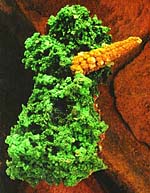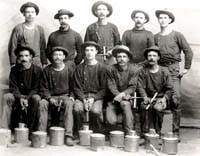
 |
Preserving Bisbee's Incomparable Mineral Heritage
What Do We Mean By A Bisbee Mineral Hall?
How Do We Plan To Build This Mineral Hall?
 |
|
 |
Specimen courtesy of the Arizona-Sonora Desert Museum
© BM&HM - All Rights Reserved
he Bisbee Mineral Hall will be part of the Bisbee Mining & Historical Museum, located upstairs in the century-old former offices of the Copper Queen Consolidated Mining Company.
The framework of the Hall will be mining square sets, used extensively in the Copper Queen Mine, where many of the first exotic minerals of the Warren Mining District were discovered.
This is to be an "environmental exhibit", placing the display minerals in a context similar to that in which they were originally discovered. Interwoven throughout the exhibit will be the voice of the miner, whose hard toil underground brought these fabulous examples of natures handiwork to light.
Accompanying the exhibits will be a variety of educational stations and activities designed to make Bisbee minerals and the science of geology come alive for visitors of all ages, from the youngest students who have never been exposed to the rudiments of rock and mineral collecting, to the grizzled old prospector, perhaps even a miner who worked the very stopes of Bisbee and who saw these minerals in their natural environment. There will also be a research library at the Museum, containing both literature and examples of all the varieties of minerals found in Bisbee.
The Bisbee Mineral Hall project was introduced to the community of Bisbee in the winter of 1996. During 1997, a planning team will be formed to begin evaluation of the projected audience, educational goals, and the content of the Mineral Hall itself. In 1998, a concept design team will be formed to begin mapping out the actual design of the Hall. Parallel to this teamwork, fundraising will be an ongoing process, with financial support sought from both the private and public sectors.
Page Contents
erein lies the enduring fame of Bisbee. There are at least a dozen copper deposits worldwide whose metal production has or will exceed that of the Warren Mining District in and around Bisbee, but only one other mine can claim such an abundance of remarkably fine specimens. Specimens from Bisbee are among the finest in the entire world, and are proudly counted among the prizes of such renowned collections as the National Gem & Mineral Collection housed in the new Janet Annenberg Hooker Hall of Geology, Gems, and Minerals inside the National Museum of Natural History, the Harvard University Mineralogical and Geological Museum, the Collection of the Arizona-Sonora Desert Museum, and the University of Arizona Mineral Museum.
During the years that Bisbee sent forth its impressive flow of minerals, more than 30 separate mines were involved. However, as a fine source of minerals, Bisbee's caves were exceptional. As described in 1904, "the walls of these caverns were covered with velvety moss-green malachite and sparkled with the blue crystals of azurite, while from the roofs hung translucent stalactitic draperies of calcite, delicately banded and tinted with the salts of copper."
The Bisbee mines have produced in excess of 300 distinct mineral species. Of these, paramelaconite, shattuckite, chalcoalumite, graemite, kiddcreekite, henryite and spangolite were originally described from Bisbee.
Unfortunately, it has been fully 20 years since the mines of Bisbee ceased production, and 10 years since the pumps in the Junction Shaft were stopped, allowing the mines to slowly flood. Today, few, if any, of the areas that could yield further information on Bisbee's mineralogical heritage are accessible. There are, however, a great many specimens preserved in collections that, upon examination, might provide a more complete understanding of Bisbee's wonderful mineral legacy - thus the Bisbee Mineral Hall.
 |
|
 |
© BM&HM - All Rights Reserved
ow can a Mineral Hall ever be built in Bisbee? Such an endeavor would have to be expensive.
That is correct. Creation of a world-class Bisbee Mineral Hall, a fitting home for world-class Bisbee minerals, will be expensive. Yet there are several competitive advantages which Bisbee possesses:
First, the Bisbee Mineral Hall will be a part of the Bisbee Mining & Historical Museum, a nationally recognized institution that has extensive experience, and a national reputation, for building first-quality exhibits. Second, there are many who already have offered their assistance in making it come together, all the way from the local to the national scene. For instance, the design, production, and maintenance of this website is just just one example of how people are coming forth to donate their time, expertise, energy and money to help this project succeed. Third, the quality and beauty of Bisbee minerals are recognized by millions of collectors around the world. This website will help us to determine to what extent you, as collectors and admirers of Bisbee's mineralogical record, will choose to participate in the creation and upkeep of Bisbee Mineral Hall.
Page Contents
The Bisbee Mineral Hall is looking for help from the mineralogical community. There are many ways you can help:
Ideas. As planning progresses, there will be public input sessions that will invite those with special interest and knowledge to participate. Minerals. One motivation for the creation of the Bisbee Mineral Hall is to serve as a repository for Bisbee minerals and collections. Without such a facility, many of the finest specimens have left town - or the country. The Bisbee Mineral Hall hopes to encourage donations or loans of important minerals, specimens and collections. Funding. A five-year project, the Bisbee Mineral Hall is encouraging supporters to make a five-year pledge. If you wish to support the creation of the Bisbee Mineral Hall, please consider pledging from $5 to $5,000 every year for five years.
Page Contents
Please contact the Bisbee Mining & Historical Museum, and let us know you would like to help! You can call us, email us, or visit us the next time you are in Bisbee. In addition to these methods of contact, this web site will soon be expanded to include an online form for memberships and contributions, as well as lots of more information and examples of what is happening with the Bisbee Mineral Hall, so stay tuned!If you simply can't wait to make a contribution, please feel free to send your pledge to us right now, by mailing your check to us at the following address:
Bisbee Mining & Historical Museum
Mineral Hall Project
P.O. Box 14, Bisbee, Arizona 85603Please include your Name, Address, Phone and email information, and let us know if you would like more information about the Bisbee Mineral Hall, if you would like to inquire about donating a specimen or collection to the Bisbee Mineral hall, or if you would like to join one of the Bisbee Mineral Hall planning teams and be kept informed of their progress.
Thank You!
Page Contents
Preserving Bisbee's Incomparable Mineral Heritage
| All materials and photographs within this site are copyright and courtesy of the Bisbee Mining & Historical Museum. Any duplication or re-distribution of this material is prohibited.
Site design, construction & maintenance |



